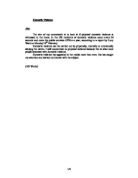Social abuse involving social isolation derived from geographical isolation (perhaps living on a property miles from anywhere), from the husband's withdrawn behaviour or from forbidding his wife contacts. Samyia-Coorey (1987) describes the added burdens for victims in rural areas, who do not have access to services or to friends and neighbours who might help, where transport is expensive, where communities are small and word gets around, and where there is disproportionate ownership of guns (and a disproportionately high homicide rate using guns: Wallace, 1986).
Economic abuse involving control by the husband or male partner of financial resources. Money may be denied and the wife may herself forego clothes or even food in order to 'manage'. She may not have access to bank accounts or to a car in order that 'she can't squander money'.
Sexual abuse involving non-consensual sexual intercourse or other acts, perhaps including threats or use of a weapon. Women endure this, perhaps believing that it is their duty to meet such demands, or fearing that their spouse will go elsewhere for 'satisfaction'.
In most physically violent relationships these forms of abuse are also present, though they may also exist without the presence of physical abuse.
The extent of the problem
It is difficult to estimate the extent of domestic violence because of a lack of suitable data. No prevalence studies have been conducted in Australia, phone-in surveys are limited by the self-report status of the respondents, and statistics collected by agencies such as police, refuges and crisis care services are fragmented. Furthermore, such agency statistics refer only to those persons who come to the attention of the agencies. We know that middle-class victims are less likely to report violence or enter refuges. We also know that many cases are never reported to any agency. A recent phone-in survey conducted in 1988 for the Queensland Domestic Violence Task Force revealed that 12 per cent of respondents had never spoken to anyone about the violence, and only 56 per cent had contact with police, in spite of the fact that they may have sustained serious injuries.
The costs of domestic violence
There are devastating consequences of violence to individuals and their families in terms of their physical and psychological health. Given that the propensity to commit violence within the home appears to be passed on from generation to generation, the problems are compounded.
The implications for health, welfare and criminal justice provision are staggering. In 1986-1987 refuge funding in Australia cost $27.6 million, and this is the tip of the iceberg. One must add to this figure the direct costs of policing, hospital and other medical services, court services and legal consultations, marriage guidance and other types of counselling, social security payments, housing provision and so on.
For the first time in Australia a study has costed domestic violence in dollar terms (Roberts, 1988). Data were derived from case histories of twenty women who were victims of domestic violence, taking into account the costs of services generated, other direct costs of compensation and superannuation payouts, and indirect costs relating to potential income lost. The costs incurred were well over $1 million for these twenty victims alone.
Legislating against domestic violence
The first of recent Australian legal reforms designed to assist the management of domestic violence cases was introduced in New South Wales in 1983. Since that time, all Australian states except Queensland have introduced similar legislation, and new legislation is presently under consideration by the Northern Territory. Queensland has recently completed (October 1988) a task force inquiry which, in line with other state and territory task force inquiries over the last six years, recommended that separate legislation be introduced 'to provide for the protection of victims of domestic violence from continued violent or abusive behaviour by a spouse'.
The main thrust of the new legislation is similar in the different States, and is broadly modelled on legislation introduced in the USA, the UK and Canada. Features include: definitions of the range of offences which constitute domestic violence; the availability of a protection order from a court where there is actual violence or a reasonable fear of violence, whether the spouse is lawful or de facto, and whether or not the couple is cohabiting; making the onus of proof on the civil standard of 'balance of probabilities'; extension of the protection order to cover others in the same household, particularly children; encouraging the laying of charges by police, rather than placing the full onus of responsibility for informing onto the victim; provision for the compellability of spouses as witnesses; extension of police powers of entry to a dwelling where a domestic violence offence is suspected to have occurred; and making a breach of a protection order a criminal offence and automatic grounds for arrest.






